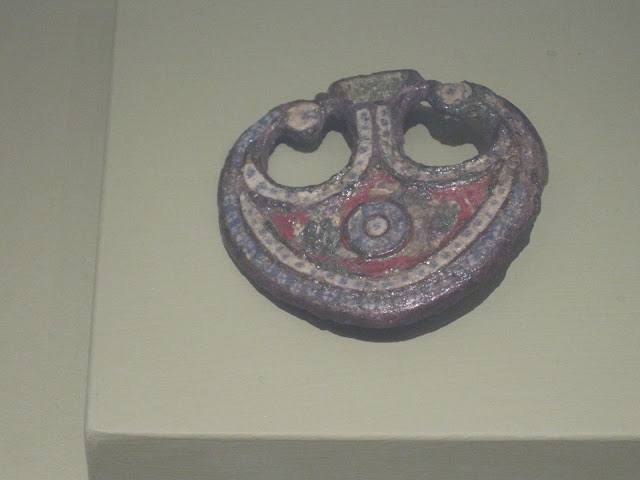The Vindolanda museum is located at and expanded from the house at the back of the site. It was purchased by Eric Birley in the 1930's for excavating, documenting, and displaying finds from the site. His work transformed the chronology of Hardian's wall and set the way modern historians view the Roman army. Two of his sons and a grandson are involved with the trust and site. Wiki site for Vindolanda is here.
The nature of the anoxic earth preserves many items that would normally decompose, like these shoes. The presence of so many styles and methods has given new insight on Roman footwear.
A horse chamfron or ceremonial facemask, original at bottom and replica on top.
The Newstead helmet. It has cupids, one flying and the other driving a chariot with two leopards. This is one of three Flavian cavalry helmets found in two pits outside the fort.
Just some of the many coins found here.
Tombstone of an unknown female, reused to make repairs in the 4th century.
A woman's wig made from hair moss.
The Gladiator Glass. These two pieces were found at different times, 1992 and 2007, more than 20 meters apart. It was imported from the Rhineland during Roman times.
Various jewelry.
An enameled brooch
Various keys
Samian ware
This picture is very hard to see but I included it to discuss the item. It is part of the Vindolanda tablets, the oldest surviving handwritten documents in Britain. They are written on postcard sized wooden leaf tablets and 782 have been transcribed with more found as excavations continue. An on-line record exists here and here. They are an excellent example of Roman peoples lives on the British frontier. This one in particular is regarding Flavius Cerialis and sixty-seven tablets have been found and scanned regarding him alone (link here). The most famous one is the oldest correspondence between two women in Britain yet found, between Claudia Severa and Suphicia Leepidina (wife of Flavius Cerialis). The translation is as follows:
Claudia Severa to her Lepidina greetings. On 11 September, sister,
for the day of the celebration of my birthday, I give you a warm
invitation to make sure that you come to us, to make the day more
enjoyable for me by your arrival, if you are present . Give my greetings
to your Cerialis. My Aelius and my little son send him their greetings.
(2nd hand) I shall expect you, sister. Farewell, sister, my dearest soul, as I hope to prosper, and hail. (Back, 1st hand) To Sulpicia Lepidina, wife of Cerialis, from Severa."
Amazing isn't it that something around 100 CE, over 1900 years ago, can make the past come alive.














No comments:
Post a Comment